Written for Interactions magazine by Shelley Evenson and Hugh Dubberly.
Design
Designers often speak of design as a process. Typically, design thinking leads to design making, which leads to artifacts. Yet the design process also leads to something more—to new knowledge. Thus, we might characterize designing as a form of learning.
Curiously, the converse is also true. We might characterize learning as a form of designing. That is, the process of observing, reflecting, and making (and iterating those steps) may aid learning. Several designers and teachers have recognized the link between designing and learning and are bringing designing into curricula not just in college but also in high school and even elementary school. See, for example, a recent New York Times article, “Putting New Tools in Students’ Hands” [1].
I acknowledge framing designing as learning (without providing further explanation) may be little more than trading one black-box process for another, but if we can find robust models of learning, they might prove useful in designing and might suggest ways to improve the design process.
The connection between designing and learning was brought into sharp focus for me last summer while editing an article by Maurício Manhães [2], who wrote, “Design and innovation are both knowledge creation processes” [3]. What struck me about Manhães’s article was that he introduced the SECI model of knowledge creation and explicitly applied it to analyzing and improving the design process. I was further struck by the similarity or even isomorphism of the SECI model and the analysis-synthesis bridge model described in this forum in the March + April 2008 issue [4].
Introducing the SECI model
The SECI model comes out of research in “knowledge management,” which is related to “organizational learning,” “business administration,” and “information systems.” SECI stands for socialization, externalization, combination, internalization—a model of knowledge creation proposed by Ikujiro Nonaka [5]. (It’s interesting to note that Nonaka received his MBA (1968) and Ph.D. (1972) from UC Berkeley, when West Churchman was teaching in the business school and offering seminars that included design-methods pioneers Horst Rittel and Christopher Alexander, who were on the faculty of the UCB College of Environmental Design.
The problem of managing knowledge created in the design process is described by Horst Rittel in his work on Issues Based Information Systems (IBIS), which helped spawn an area of research in computer science known as design rationale [6].)
Nonaka sees ongoing knowledge creation as the source of continuous innovation and continuous innovation as the source of sustained competitive advantage. “When organizations innovate, they do not simply process information, from the outside in, in order to solve existing problems and adapt to a changing environment. They actually create new knowledge and information, from the inside out, in order to redefine both problems and solutions and, in the process, to re-create their environment.”
Nonaka considers knowledge “as a dynamic human process of justifying personal belief toward the ‘truth.’…This understanding emphasizes that knowledge is essentially related to human action….As a fundamental basis for the theory of organizational knowledge creation, we focus attention on the active, subjective nature of knowledge represented by such terms as commitment and belief that are deeply rooted in individuals’ value systems.” [7][Italics are from the original.]
“The basic argument is that knowledge creation is a synthesizing process through which an organization interacts with individuals and the environment to transcend emerging contradictions that the organization faces” [8].
The process moves from tacit knowledge to explicit knowledge and back. “Tacit knowledge is personal, context-specific, and therefore hard to formalize and communicate. Explicit or codified knowledge, on the other hand, refers to knowledge that is transmittable in formal, systematic language” [9]. Tacit knowledge tends to be specific to a context (available in a particular time and place), practical, routine, and procedural. Explicit knowledge can transcend a specific context (and is transferable to other times and places) and tends to be rationalizing, theoretical, and declarative.
Nonaka postulates four modes of “knowledge conversion that are created when tacit and explicit knowledge interact.”
- Socialization (tacit to tacit) “is the process of converting new tacit knowledge through shared experiences in day-to-day social interaction.”
- Externalization (tacit to explicit) is a process whereby “tacit knowledge is articulated into explicit knowledge…so that it can be shared by others to become the basis of new knowledge.”
- Combination (explicit to explicit) is a process whereby “explicit knowledge is collected from inside or outside the organization and then combined, edited, or processed to form more complex and systematic explicit knowledge…The new explicit knowledge is then disseminated among the members of the organization.”
- Internalization (explicit to tacit) is a process whereby “explicit knowledge created and shared throughout an organization is then converted into tacit knowledge by individuals…This stage can be understood as praxis, where knowledge is applied and used in practical situations and becomes the base for new routines.”
Successive iterations of the process form a spiral, with each loop amplifying the knowledge to a higher-level knowledge-creating entity; the process moves from individual to group to organization to community of organizations.
How the SECI Model Maps to the Analysis-Synthesis Bridge Model
The goal of this article is to introduce the SECI model to the design community. At the same time, this article also argues the SECI model and the analysis-synthesis bridge model are not just similar but also isomorphic. That is, they use different terms to describe essentially the same process. More precisely, the analysis-synthesis bridge model and related models [4] (Robinson model, Kumar innovation model, Kaiser/IDEO model, and Suri/IDEO model) are specific instances of the more general SECI model. (The Beer model and Alexander model are slightly different, though still roughly analogous. The 1966 Beer model is interesting in relation to SECI, as it describes the process of applying scientific models to managerial situations, a special form of knowledge creation.)
The analysis-synthesis bridge model describes a four-step design process. It begins with 1. directly observing a current situation, 2. reflecting on observations of the current situation to create a model representing essential elements, 3. reflecting on the model of the current situation to create a second model representing essential elements of an improved situation, and 4. instantiating the second model in a physical form or prototype. The process described by the analysis-synthesis bridge abstracts essential characteristics of both current and improved situations as a “scaffold” for moving from researching to making in the design process; using models as a bridge may be especially useful in complex areas of practice, such as software design, service design, and systems design, where the path from researching to making may often be unclear.
The four steps of the analysis-synthesis bridge model correspond to the four steps of the SECI model:
Step 1
Observing the current situation is a form of socialization. Insight-gathering methods or problem-finding methods, such as ethnography, often rely on acquiring tacit knowledge through inhabiting a specific context and interacting with others in that context. Nonaka writes, “The key to acquiring tacit knowledge is experience. Without some form of shared experience, it is extremely difficult for one person to project her- or himself into another individual’s thinking process.”
Step 2
Modeling the current situation is a form of externalization. Sharing one’s experience and insights with others, for example, writing an ethnography, requires abstracting and generalizing. Nonaka writes, “Externalization…is the quintessential knowledge-creation process in that tacit knowledge becomes explicit, taking the shapes of metaphors, analogies, concepts, hypotheses, or models.” He adds, “To make a hidden concept or mechanism explicit out of accumulated tacit knowledge, abduction, or retroduction is effective rather than induction or deduction.”
Step 3
Modeling a better situation is a form of combination. A designer looks at aspects of what is and imagines combining them with other things that he or she has experienced or imagined. Nonaka writes that combination “synthesizes knowledge from many different sources in one context. The combination mode of knowledge conversion can also include the ‘breakdown’ of concepts. Breaking down a concept…also creates systemic, explicit knowledge.”
Step 4
Instantiating a model is a form of internalization. Prototyping requires working out many details and determining many relationships, creating a new level of knowledge of the model on which the prototype was based. Nonaka writes, “Explicit knowledge, such as product concepts or manufacturing procedures, has to be actualized through action, practice, and reflection so that it can really become knowledge of one’s own.”
The bridge model is a specific instance of the SECI model.
Rotating the SECI model 90º counter-clockwise aligns it with the bridge model—so that they both “begin” in the lower left corner.
By rotating the SECI model, we can see that Socialize and Externalize tend to look backward at more known situations, and Combine and Internalize tend to look forward to less known situations.
Like the SECI model, the analysis-synthesis bridge model comprises four quadrants of a two-by-two matrix. In the SECI model, step 1 is in the upper left corner. In the analysis-synthesis bridge model, step 1 is in the lower left corner. Rotating the SECI model 90 degrees counter-clockwise aligns the two models. Nonaka does not label columns or rows in the SECI model. However, the analysis-synthesis bridge model labels the bottom row “descriptive/concrete” and the top row “interpretive/abstract.” The left column is “researching a current situation,” while the right column is “prototyping a future situation.” It’s not much of a stretch to apply these labels to the rows and columns of the SECI model.
The SECI model explicitly describes the iterative nature of the knowledge creation process by including a spiral. The analysis-synthesis bridge model does not refer to iteration directly, though the authors assume readers understand the design process as iterative. However, the Kaiser/IDEO model, which is isomorphic to the analysis-synthesis bridge model, includes a loop. And Kumar’s innovation model, which is also isomorphic, does explicitly include a spiral!
The SECI model is just one part of Nonaka’s theory of knowledge creation, which also comprises Ba and dialectic. Ba is a shared “place” or context—loosely bounded and evolving—that “enables a dialectic process among the actors.”
“A firm can be viewed as an organic configuration of various Ba, where people interact with each other and the environment based on the knowledge they have and the meaning they create.” This notion is similar to the Geogeghan and Pangaro notion that a firm is a collection of conversations for understanding, agreeing, acting, and learning [11]. Nonoka argues that “knowledge is created through the synthesis of the contradictions between the organization’s internal resources and the environment.” His notion of the dialectic spiral of synthesis of contradictions is similar to Rittel’s notion of designing as a process of reframing and argumentation.
While outside the scope of this article, Nonaka’s notion of Ba and his insistence on Ba and dialectic as parts of the knowledge-creation process suggest further opportunities for applying his work to designing.
Conclusion
Today, the practice of software and service design—indeed most design practice—is ad hoc, performed on an ‘as-needed’ basis and adapted to whatever context the designers encounter. Most design work still proceeds on an industrial-age model of ‘edition’ and project, in which design is ‘finished’—rather than on an information-age model of continuous improvement, multi-year beta, and organic growth, in which design is never finished. In the future, successful software and service organizations will recognize that software and service design are ongoing processes. Each design iteration and implementation leads to new knowledge. We need systems to identify, capture, and build on that knowledge in an ongoing process, if we are to develop a design practice appropriate for an information and services economy [10]. Applying the SECI model to designing is a step in the right direction.
If both the SECI model and the analysis-synthesis bridge model reasonably represent their subjects—learning (or knowledge creation) and designing—and if the models are isomorphic, then we may say that learning and designing are isomorphic, at least from one frame.
This conclusion has profound ramifications for both business practice and design practice. For business practice, it suggests that since knowledge creation is a central activity of the firm then designing is also a central activity of the firm. That is, designing is an important form of knowledge creation and thus the heart of value creation within the firm. For design practice, it suggests further study of the mechanisms of knowledge creation and knowledge management and their relation to traditional and emerging notions of designing. That is, learning is an important part of the design process, not just in design education and academic design discourse, but especially as design is practiced.
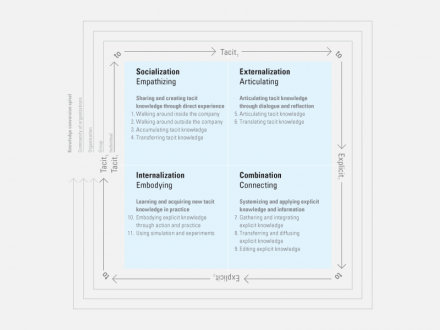
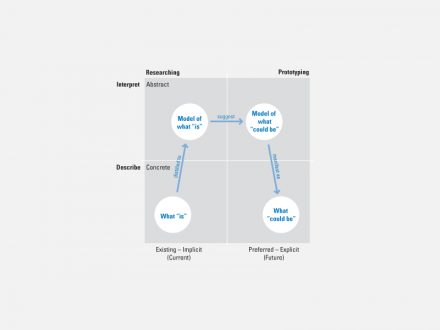
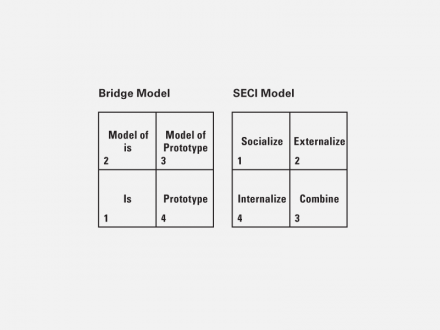
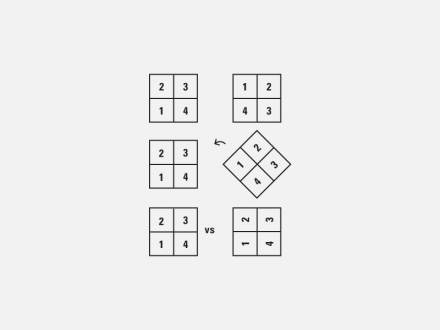
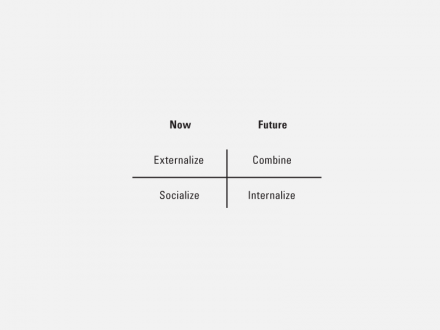
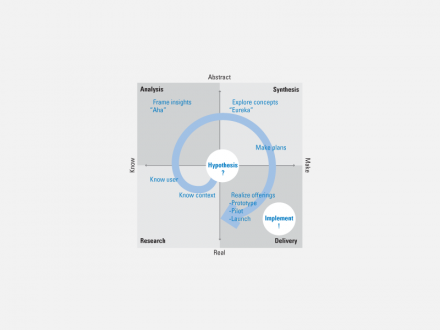
4 Comments
Elisha
Jun 8, 2011
12:59 am
wow thank you very much for all this infor.
It sure helped a lot in many ways, hope that this will not be the end but you will come up with something new and in fact, one day will take your foot steps so it never die.May God bless you and add more helpful topics and fact
Kent S.
Dec 6, 2011
3:36 pm
Just glancing at the article, I cannot help wonder if you’re aware of the work of Ken Wilber? All those quads! http://www.formlessmountain.com/quads.htm
rutto jackline
Nov 12, 2014
2:11 am
congratulation for helping me understand this model and do my assignment
Arthur Battram
Dec 7, 2017
2:15 am
Check out Situated Learning by Lave and Wenger